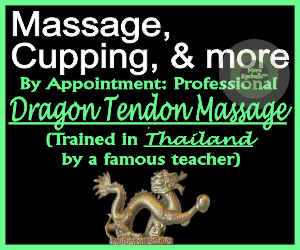Deep tissue massage is a specific genre of massage that focuses on the deep layers of muscle and fascia (the dense connective tissue that surrounds muscle fibers and supports other body tissues in the body). It is recommended as a treatment option to treat various ailments such as reducing chronic pain, and improving blood pressure.
The University of Maryland Medical Center reports that deep tissue massage is often more affordable and effective in relieving chronic pain than more conventional medical remedies, because deep tissue massage increases the blood flow throughout the body and thereby reduces inflammation and muscle tension.
Also, according to the same source, deep tissue massage helps ease stress and tension allowing for a reduction in systolic blood pressure. Deep tissue massage can also help increase the body’s production of serotonin — the “feel good” hormone that promotes relaxation.
There are many types of massage, with many different names, however, massage can be categorized as three basic types. Acupressure refers to a massage style that originates in Asia that focuses on pressure points and the movement of energy through the body. Swedish massage focuses on improving circulation of blood and lymph while relaxing superficial muscles. Deep tissue work produces changes in movement and posture by directing the pressure to muscles and the fascia.
Deep tissue massage is performed by specially trained massage therapists to improve athletic performance, promote relaxation and to help promote proper function in scarred and inflamed areas of the body. The Associated Bodywork and Massage Professionals note that deep-tissue work can help while recuperating from injury and muscle pain by assisting in breaking up scar tissues associated with injuries.
I spoke with local deep tissue massage therapist Benjahmin Koenigsberg from Kauai Deep Tissue Massage. He specializes in treating neck and shoulders, hips and low back as well as feet and lower legs. Benjahmin stated that deep tissue work can be a highly pleasurable experience as well as an effective method for reducing pain and improving movement and posture.
He added that some people have had unpleasant experiences simply because the therapist used too much pressure and didn’t “check-in” with their client about the pressure level. He further stated that it is important for the therapist and the client to work together to achieve the correct pressure and to help identify the cause of the client’s imbalances in the body and work to achieve healing.
Benjahmin notes that rather than a passive experience such as you might experience with Swedish massage, in deep tissue work the client is more actively participating to let go of their tension.
In deep tissue work, the therapist focuses on deep underlying fascia, using enough pressure to loosen up the areas that have stuck together … these areas are commonly referred to as “knots.”
Fascia can get dehydrated due to stress, lack of fluid or movement and therefore it get sticky and thick, and bind to itself and the nearby muscles and structures. Benjahmin noted that knots often form where multiple muscles intersect.
The pressure needed to successfully treat the knotted areas may be slightly uncomfortable at times, but it is a misconception that deep tissue massage ends in bruising or must be painful. The treatment is meant to reduce pain and inflammation, not create it. The work is intended to hydrate the fascia by stimulating metabolic waste products out of cells and to bring in fresh blood and nutrients to the area.
Usually a deep tissue massage will focus only on a few target body areas per session in order to effectively address the imbalances present there.
The Institute for Integrative Healthcare Studies states that deep tissue massage of an injured area with scar tissue can help increase the flexibility and range of motion in the area and can help prevent re-injury as well as relieve the pain caused by nerve impingement.
Eating right, moving well and finding non-drug, and non- surgical alternatives to reducing pain and increasing mobility all speak to a natural way of healthy living. Aloha!
•••
Dr. Jane Riley, Ed.D., certified personal fitness trainer, nutritional adviser, behavior change specialist, can be reached at janerileyfitness@gmail.com, 212-8119 cell/text, www.janerileyfitness.com.
© 2017 Thegardenisland.com. All rights reserved. This material may not be published, broadcast, rewritten or redistributed.
Let's block ads! (Why?)
The University of Maryland Medical Center reports that deep tissue massage is often more affordable and effective in relieving chronic pain than more conventional medical remedies, because deep tissue massage increases the blood flow throughout the body and thereby reduces inflammation and muscle tension.
Also, according to the same source, deep tissue massage helps ease stress and tension allowing for a reduction in systolic blood pressure. Deep tissue massage can also help increase the body’s production of serotonin — the “feel good” hormone that promotes relaxation.
There are many types of massage, with many different names, however, massage can be categorized as three basic types. Acupressure refers to a massage style that originates in Asia that focuses on pressure points and the movement of energy through the body. Swedish massage focuses on improving circulation of blood and lymph while relaxing superficial muscles. Deep tissue work produces changes in movement and posture by directing the pressure to muscles and the fascia.
Deep tissue massage is performed by specially trained massage therapists to improve athletic performance, promote relaxation and to help promote proper function in scarred and inflamed areas of the body. The Associated Bodywork and Massage Professionals note that deep-tissue work can help while recuperating from injury and muscle pain by assisting in breaking up scar tissues associated with injuries.
I spoke with local deep tissue massage therapist Benjahmin Koenigsberg from Kauai Deep Tissue Massage. He specializes in treating neck and shoulders, hips and low back as well as feet and lower legs. Benjahmin stated that deep tissue work can be a highly pleasurable experience as well as an effective method for reducing pain and improving movement and posture.
He added that some people have had unpleasant experiences simply because the therapist used too much pressure and didn’t “check-in” with their client about the pressure level. He further stated that it is important for the therapist and the client to work together to achieve the correct pressure and to help identify the cause of the client’s imbalances in the body and work to achieve healing.
Benjahmin notes that rather than a passive experience such as you might experience with Swedish massage, in deep tissue work the client is more actively participating to let go of their tension.
In deep tissue work, the therapist focuses on deep underlying fascia, using enough pressure to loosen up the areas that have stuck together … these areas are commonly referred to as “knots.”
Fascia can get dehydrated due to stress, lack of fluid or movement and therefore it get sticky and thick, and bind to itself and the nearby muscles and structures. Benjahmin noted that knots often form where multiple muscles intersect.
The pressure needed to successfully treat the knotted areas may be slightly uncomfortable at times, but it is a misconception that deep tissue massage ends in bruising or must be painful. The treatment is meant to reduce pain and inflammation, not create it. The work is intended to hydrate the fascia by stimulating metabolic waste products out of cells and to bring in fresh blood and nutrients to the area.
Usually a deep tissue massage will focus only on a few target body areas per session in order to effectively address the imbalances present there.
The Institute for Integrative Healthcare Studies states that deep tissue massage of an injured area with scar tissue can help increase the flexibility and range of motion in the area and can help prevent re-injury as well as relieve the pain caused by nerve impingement.
Eating right, moving well and finding non-drug, and non- surgical alternatives to reducing pain and increasing mobility all speak to a natural way of healthy living. Aloha!
•••
Dr. Jane Riley, Ed.D., certified personal fitness trainer, nutritional adviser, behavior change specialist, can be reached at janerileyfitness@gmail.com, 212-8119 cell/text, www.janerileyfitness.com.
© 2017 Thegardenisland.com. All rights reserved. This material may not be published, broadcast, rewritten or redistributed.
Let's block ads! (Why?)




































































































